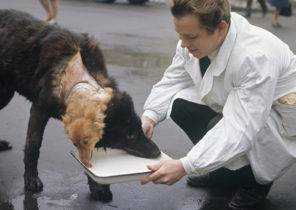
Domestic pigs, those are the most carefree creatures with twisted tails, which are depicted in bright pink neon background over the pieces of meat to BBQ, have a phenomenal memory. In solving problems on the computer they are competing in wit with young children and win. They are able to think ahead and form a complex social community. They perceive relatives as individuals.
Pigs are not only considered, they have heart. They can Express concern and sympathy when others are in trouble. One of the descriptions of the behavior of pigs resulting from scientific experiments and drafted Lori Marino (Lori Marino) from the center for the protection of animals “Kimmel” and Christina Colvin (Christina M Colvin) from the Georgia Institute of Technology, leaves so deep an impression as if we are talking about chimps, elephants or whales.
But we still eat pigs, and eat the scale is not comparable with the consumption of meat of other sentient mammals. According to the Food and agriculture organization, pork is the most consumed meat in the world.
In many countries, the barbecue has become a cultural obsession, like bacon, whether in traditional form or in original combinations with chocolate or vodka. And some was full of real bacon, go clean your teeth with bacon-flavored before bedtime.
We appreciate the taste of pork so much more than life themselves pigs. With the exception of the pig-celebrity, famous and loved by all, and therefore received the status of protected and not intended for human consumption pet. For example, at home Canadians Derek Walter (Derek Walter) and Steve Jenkins (Steve Jenkins) in Ontario lives trehsotmillionnogo “wonder pig” ester, which is the “public face” on Facebook and having over a million subscribers.
Or, take, for example, Christopher Hogwood (named after the famous English conductor and musicologist), a pig that lived in the barn at the house of Sy Montgomery (Sy Montgomery) and Howard Mansfield (Howard Mansfield) in the state of new Hampshire from infancy until his death at the age of 14 years. Christopher had grown even more, Esther, and through the memoirs of Montgomery under the title “the good, Good pig” (2006) is an example of pig cognition and emotion.
Montgomery describes how the scratching of the belly, or the leftovers of dinner from a local chef led Christopher into a state of utter delight is obvious to all: he conveyed his emotions through sound “UN-UN” and taking a certain posture. At such moments it seemed perfectly reasonable mammals, appreciating the moment. But today Christopher did not live more than we do. He built nests, but not mechanically or by instinct, but fussy in anticipation of their own convenience on the soft hay. He had an excellent memory for some people — its own complex social community. Two neighborhood kids continued to visit him regularly even after moving to another state. “He still remembered those girls, told me Montgomery, and it is not only a long separation, but in the metamorphoses of adolescence, when just a few months can change everything: looks, height, voice timbre and the smell”. When interacting with people which looked sad clearly the voice of Christopher “became softer and below” — a kind of feat in the perception of the situation from the point of view of other people and a hint of empathic reaction.
Of course, stories about pigs as individuals have to review people of the question of pork and bacon. But what this says about the science — that area looked at Marino and Colvin? This question troubled me for several years.
Some science begins with the assumption that pigs are not particularly intelligent and sensitive animals. Two years ago a group of researchers under the leadership of zoologist Brion Sophie (Sophie Brajon), who worked at that time at the University of Laval in Quebec, has published a research report on the impact of human behavior on the emotional state of pigs. This study is part of the anthology, demonstrating that emotional state of animals, including agricultural, has an indirect effect on the processing of information by them. But the findings, according to which the piglets, which was good, showed a more positive emotional state compared to those who did not pay attention or handled roughly — are designed to convey to people the global idea: much remains to be done to the understanding that animals are emotional and are influenced by our attitude toward them became taken for granted, not a great discovery.
A significant part of the scientific texts about pigs aimed at raising awareness about the abilities of these animals and the improvement of attitudes of the person. Biologist Donald broom (Donald Broom) and his colleagues at Cambridge University found that just five hours of training pigs could use the reflection in the mirror for finding a hidden object. To conduct this experiment pigs looking for a treat for the mirror, but after a five-hour practice ten of the eleven subjects required no more than 23 seconds to turn around and find a valid location “Goodies”. (To avoid skewing the results of the process used fan.) This is a cognitive feat, because the animals had to memorize not only the fact of availability of food but also its location in terms of a distorted reality mirror.
The cognitive ability of pigs is huge. Biologist Candace Krone (Candace Croney) from Purdue University in Indiana, describes cognitive studies of pigs, which were conducted as a graduate student. At first a lot she did not expect: “I thought pigs are stupid, dirty animals,” she says. Even the names she gave to the objects of their studies, suggests that illusions about their cognitive abilities she had no: one pair called Pork and Beans, the other hamlet and Omelette, and a third that was just inevitable — scrambled Eggs and Bacon.
A thorough study of Crone did not meet her expectations. Together with colleagues, she has conducted original experiment: everybody gets a wooden bar in the shape of the letter X or On and began to walk around pigs. Fed animals only those in whose hands was the O-shaped bars. And soon the animals began to walk behind them — which is not surprising. The researchers then postponed wedges and wearing t-shirts with images of the same letters, and pigs transferred the acquired knowledge to the conditions of the new situation, coming only to the owners of t-shirts with the letter O. They “learned” the meaning of the symbol, simplified to two dimensions from three.
Krone also subjected pigs to test on the computer, and as their opponents were little kids. The goal was to move the joystick to the target with the snout, or hands. Results pigs were better than the kids.
You should also know that pigs can solve problems in a logical way. Recent scientific discoveries and inventions show that the pig operates some kind of internal setup. They remember everything that happens to them, and understand that represents the past. They actually can think, feel, solve problems and to Express individuality. We all should eat them?
What other psychological or emotional feats need to go to the pigs, to convince people to stop eating them? Perhaps this question is not quite correct. Eating pigs is a culture of practices associated with traditions and family values. No anthropologist will not seriously argue that it can somehow be eradicated. In addition, even Pets are not immune from having to be on the plate, as in the case of an annual dog meat festival in Yulin, the Chinese province of Guangxi. And the story of cannibalism proves that humans eat their comrades not only in extreme situations like survival of the crash in some godforsaken location, or in distress climbers. In Chinese history there was a practice of honoring parents, demanded a sign of devotion to chop off a limb and serve with rice porridge, a beloved relative who starved or was ill. And medical practice in Europe, the Renaissance included the ingestion of bodily fluids of other people.
But on the way to our tables pigs are subjected to boundless suffering. In the USA of 100 million grown on pig slaughter, 97 percent are sent to agro-industrial farms. Such farms, or, as they are called, CAFO (concentrated animal-feeding operations — concentrated operations feeding animals) can be described as “vast lagoons of pig feces”. They cause serious harm to the environment and to live happily ever after pigs are not allowed.
One of the workers “blood pit” of a slaughterhouse, who gave an interview to Jonathan SAFRAN Teru (Jonathan Safran Foer) for the book “Eating animals” (2009), describes emerging in such places the culture of aggression. Often just to kill a pig is not enough. “You come in sharply, sharply pushing and interrupt the trachea, causing the animal to choke on their own blood. Punch him in the nose, the worker says. — Life pig runs around the pit, looks at me, and I’m just standing. Then you take your knife and — POPs, cut out her eyes, and she shrieks.” And that activity is not some random psychopath, they are symptomatic of the entrenched practices of violence and slaughterhouses.
There is a short film under the name “iAnimal: pig’s Eyes” (2016) joint production of Animal Equality Condition, and One that immerses the viewer in the atmosphere of one of the Mexican slaughterhouses. Two pigs are beaten on the head with a metal device to stun. They fall, but soon the mind begins to return to them, and they slowly bleed to death. Two other animals are driven into the side of the room for slaughter.
We shouldn’t eat pigs. But many of us eat. Can the knowledge that our food is able to plan, reflect and remember, to get people to stop?
In a recent letter to the professional staff on ethics issues, the New York Times Magazine, Kwame Anthony Appiah (Kwame Anthony Appiah), a reader asked whether to take a pet from the animal shelter where euthanasia is not practiced. In its reply, Appiah made a comment that revealed long-standing problem that exists even among highly educated people. “People, unlike other creatures, — he said, — build their lives themselves, and any interference deprives them of something significant.” A negative answer to the question about whether we have pigs, may require willingness to admit that the pigs have something to lose in case of death from our hands.
We know through science and history, that Appiah is wrong, and the people are not the only animals whose lives are filled with emotions, cognitive activity, memories, attachments and many others. Lots of animals from elephants and monkeys to ducks mourn if a relative dies or a close friend. They fall out of social life, refuse to eat or behave in a unusual way. There are many convincing evidence that other animals can Express emotions.
Anthropomorphism is commonly defined as an inappropriate attribution to animals of human characteristics, abilities, or emotions. But this statement cannot be regarded as absolutely accurate as the unequivocal assumption that happiness or sorrow (or deep mind) inherent in man and only him. Many people acknowledge the existence of the inquiring mind and good heart have living with them dogs and cats. What is worse than pigs?
Fouer in the book “Eating animals,” bill Niman (Bill Niman), founder of the eponymous ranch North of San Francisco, describes his first attempt in the field of animal husbandry at the age of 20 years. At first, the idea is good to cut the pig, was a real torment. But in the future, he writes, “when we, our friends and family members ate the flesh of those animals, I realized that their death served an important purpose — providing us with delicious, healthy and nutritious food.” What a sad view of life other intelligent beings!
In may, animal rights activists rejoiced when the court acquitted the founder of the society of rescue pigs in Toronto, Krainz Anita (Anita Krajnc) on charges of criminal damage, because she watered a few pigs, who were in the truck at one of the slaughterhouses Ontario in 2015. Compassionate, Krainz — echo yielded to farms, nature reserves in new York and California and sanctuary for pigs in Stanwood, Washington — not so common as could be. Krainz, demonstrates a different way of perception and attitude to pigs — and it is certainly better.
All pigs and Pets like Hogwood, and wild boars — are the same, are representatives of the same species, Sus scrofa. Currently, the rough and tough handling they are exposed to everything. In Texas there are more than 2 million wild boars can cause significant damage to the landscape. As a result of pressure from the public, the implementation of the plan for their harassment was postponed. The pigs were supposed to feed warfarin — a substance that causes internal and external bleeding, leading to death. However, in April of this year, published in the New York Times report on this proposal, it became clear that concern about the life of pigs presented for those people the lowest interest. A significant factor was the “collateral damage” for people, nature and Pets. And the hunters were worried about losing the coveted prey.
People hunting, but predators, in fact, are not. We have nothing to do with big cats caught in the trap of evolution and forced to drive and eat gazelles, or with domestic cats, are not able to adhere to a vegetarian or vegan diet. We are not even omnivorous unconditional. At the species level of the biological reasons behind the consumption of our meat there, while we have the opportunity to fill the need for plant proteins with vitamin B12.
If in our perception of pigs is still going to happen shift, and accordingly are subject to change and attitudes to food. During my telephone conversation with Montgomery about Christopher Hogwood, she appealed to all consumers of pork: “a ham Sandwich, which you eat, could bring into the lives of some other family as much as Christopher did for me, but instead became a fleeting taste sensation in a foreign language. What a horrible useless death.” Here you have a reversal in the opposite direction in views on life as pigs are not designed to please people, even for a moment. As soon as this shift in understanding, eating pigs will become what, in essence, is: “absurd, criminal murder for a single meal”, as aptly put by the Swiss primatologist Christophe bösch (Christophe Boesch).
Based on everything we know about the ability of pigs to think and feel, it is reasonable to conclude that the domestic pig would prefer to live longer than six months, designated in the CAFO. Director of farm shelter Farm Sanctuary Susie coston (Coston Susie) worked with the rescued pigs for over 20 years. And here is what she said:
“Knowing them as incredibly sociable, quick-witted and freedom-loving animals, I am disgusted with the fact that they are locked in the machine for sows or kept in barns. Many hundreds of pigs, which I had the pleasure to know, live up to 15-19 years and enjoy a rich, full life in the circle of his own family or those who they accept and who form a herd. They experience joy, love, sense of loss and pain, and if they are allowed to live and not slaughtered at the age of six months, they will be able to enjoy each day to the maximum for ten years or more”.
Does shaped by science and stories about the life of animals the understanding of their inner world to think hard about who we eat?
The exact answer to this question is no. But new research by leading psychologists talk about two things: people are less likely to perceive the quality of the food those animals, which are considered reasonable; and, on the contrary, animals perceive as food, are considered less capable of suffering and worthy of moral concern.
Such studies indicate an extremely serious problem for animal welfare activists. Due to the ongoing industrialization of the world, more and more people get the opportunity to eat meat and enjoy it. At the same time, attitudes that define the activities of the activists — that the life of pigs and other animals is no less important than human — means a waiver of one dish with pork prevents suffering, moving us one step closer to saving a life.
The suffering of pigs in our food system is obvious — how and their ability to think and experience emotions. To dwell on this or to go further — to solve to us. Only we can change people’s perceptions about the pigs.
Barbara king is Professor emerita of anthropology, College of William and Mary in Virginia. Writes for the blog “13.7 Cosmos and culture,” National Public Radio (NPR); her latest books are called “Personality on a plate: the lives and consciousness of animals used for food” (2017) and “How animals grieve” (2013).







